| July 1, 2006
More Imaginative SACD and DVD-Audio
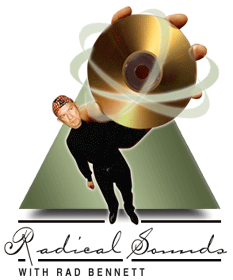 Sony BMG has used imagination in
transferring the original three-channel master tapes of some RCA Living Stereo releases to
three-channel SACDs, but the latest reissues seem the weakest so far, even as such gems as
Fritz Reiner’s Spanish collection and Puccini’s Turandot still rest in
the vaults. Still, a few titles are outstanding. (All Living Stereo SACDs are hybrids,
with CD layers that can be played on regular CD or DVD players.) Sony BMG has used imagination in
transferring the original three-channel master tapes of some RCA Living Stereo releases to
three-channel SACDs, but the latest reissues seem the weakest so far, even as such gems as
Fritz Reiner’s Spanish collection and Puccini’s Turandot still rest in
the vaults. Still, a few titles are outstanding. (All Living Stereo SACDs are hybrids,
with CD layers that can be played on regular CD or DVD players.)
One is of Mario Lanza, appropriately titled Lanza at His
Best [RCA 71625]. An interesting thing about this three-channel release is that
Lanza’s voice is isolated in the center channel, with no spill to the left or right
channel. This mix works to great effect, and it’s one of the cleanest three-channel
efforts I’ve heard. A disc of Beethoven sonatas played with spirit and élan
by Artur Rubinstein [71619] is another example of a good three-channel mix. Reiner’s
famous Pines of Rome [71614] is considerably improved by the three-channel SACD
treatment: The woodwinds are more centered, and the organ is better registered and
integrated with the orchestra. Debussy’s La Mer, on the same disc, is also
excellent. Jascha Heifetz’s recording of Bruch’s Scottish Fantasy and
First Violin Concerto [71622] is two-channel, but the high-resolution SACD transfer lets
one hear more nuance than in the CD version.
An innovative, or at least unusual, use of DVD-Audio comes
from Tacet, with recordings of Schubert’s Octet [DVD 133] and J.S. Bach’s
Brandenburg Concertos [DVD 101]. Producer Andreas Spreer believes in full sonic
immersion, and uses the rear channels for specific placement of instruments. In the
Schubert, the first violin, viola, and cello are up front, the bassoon and clarinet to the
sides, and the second violin, horn, and double bass across the back. The Bach disc
presents a different seating plan for each concerto. Schematics in the program notes spell
all of this out, making it a good test of the balance of the five channels of your
surround system. I find this type of arrangement unsettling for relaxed listening -- if I
wanted to be inside an instrumental group, I’d pick up an instrument and join one --
but I’m sure some listeners relish this sort of experience. The performances, by
Camerata Freden (Schubert) and the Stuttgart Chamber Orchestra (Bach), are first-rate, as
is the exceptionally clean and clear sound. In fact, the sound is so good that I wish
Spreer had provided a normal concert-hall mix as well.
Here are six great high-resolution recordings to take you
through the summer:
Bartók: Concerto for Orchestra
Lutoslawski: Concerto for Orchestra
Cincinnati Symphony; Paavo Järvi, conductor.
Telarc SACD-60618, Hybrid Multichannel SACD.
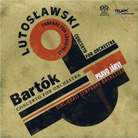 There are already two first-rate
recordings of Bartók’s famous Concerto for Orchestra available on SACD, one
conducted by Zoltán Kocsis [Hungaroton], the other the classic two-channel recording by
Fritz Reiner and the Chicago Symphony [RCA Living Stereo]. As incredible as it might seem,
Paavo Järvi’s reading surpasses both. From the opening notes, one is aware of a
feeling of keen anticipation, as each passage sets up the next. As the work unfolds, everything
sounds "right." Järvi is aware of the drama and lyricism implicit in the score,
as well as of both melodic line and accompaniment. After you’ve heard this recording
once, listen again, paying attention to the supporting instruments under the melody. I
have seldom heard a reading in which so much care has been taken with the instruments not
playing the tune. This recording is also proof positive that the Cincinnati Symphony has
become one of our great orchestras. Järvi has found a fascinating companion to the
Bartók in Lutoslawski’s dramatic work in the same form. The recorded sound is
perfect, with just the right amount of hall ambience. The orchestra sounds focused and
clear, with a warm halo of surrounding air. I never thought the Reiner recording would
lose first place, but from now on, for me, this is the reference recording of the
Bartók. There are already two first-rate
recordings of Bartók’s famous Concerto for Orchestra available on SACD, one
conducted by Zoltán Kocsis [Hungaroton], the other the classic two-channel recording by
Fritz Reiner and the Chicago Symphony [RCA Living Stereo]. As incredible as it might seem,
Paavo Järvi’s reading surpasses both. From the opening notes, one is aware of a
feeling of keen anticipation, as each passage sets up the next. As the work unfolds, everything
sounds "right." Järvi is aware of the drama and lyricism implicit in the score,
as well as of both melodic line and accompaniment. After you’ve heard this recording
once, listen again, paying attention to the supporting instruments under the melody. I
have seldom heard a reading in which so much care has been taken with the instruments not
playing the tune. This recording is also proof positive that the Cincinnati Symphony has
become one of our great orchestras. Järvi has found a fascinating companion to the
Bartók in Lutoslawski’s dramatic work in the same form. The recorded sound is
perfect, with just the right amount of hall ambience. The orchestra sounds focused and
clear, with a warm halo of surrounding air. I never thought the Reiner recording would
lose first place, but from now on, for me, this is the reference recording of the
Bartók.
Toch: Piano Concerto; Piano
Quintet
Diane Andersen, piano; Danel Quartet; Philharmonisches Staatsorchester Halle; Hans Rotman,
conductor.
Talent 2929 70, Hybrid Multichannel SACD.
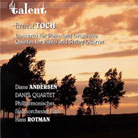 Everyone presented on this disc,
composer and performers alike, is practically unknown in the US, yet they all won me over
to want to hear more. Ernst Toch (1887-1964) was for years mostly known by the 1958
Capitol Full Dimensional Sound recording of his Third Symphony, with William Steinberg and
the Pittsburgh Symphony. Recently, there has been a renaissance of his music. His other
symphonies have now been recorded, along with many other compositions. This disc presents
the robust and quite listenable Piano Concerto, which bubbles along like something
of a cross between Bartók and Shostakovich; and the more astringent Piano Quintet.
Diane Andersen, who specializes in recording little-known music, is a powerhouse soloist
who can shade her playing from the softest whisper to a thunderous shout, and both the
orchestra and the Danel Quartet give first-rate support. The sound is amazingly clear,
with remarkable presence. Listen to the low gong strokes at the end of the concerto’s
third movement, or the hammering percussion and piano at the beginning of the final
movement, and prepare to be amazed. I would love to hear these forces make an integral
recording of the Bartók piano concertos. Everyone presented on this disc,
composer and performers alike, is practically unknown in the US, yet they all won me over
to want to hear more. Ernst Toch (1887-1964) was for years mostly known by the 1958
Capitol Full Dimensional Sound recording of his Third Symphony, with William Steinberg and
the Pittsburgh Symphony. Recently, there has been a renaissance of his music. His other
symphonies have now been recorded, along with many other compositions. This disc presents
the robust and quite listenable Piano Concerto, which bubbles along like something
of a cross between Bartók and Shostakovich; and the more astringent Piano Quintet.
Diane Andersen, who specializes in recording little-known music, is a powerhouse soloist
who can shade her playing from the softest whisper to a thunderous shout, and both the
orchestra and the Danel Quartet give first-rate support. The sound is amazingly clear,
with remarkable presence. Listen to the low gong strokes at the end of the concerto’s
third movement, or the hammering percussion and piano at the beginning of the final
movement, and prepare to be amazed. I would love to hear these forces make an integral
recording of the Bartók piano concertos.
Boccherini: Guitar Quintet in D; Quintet in
C, "La Ritirata di Madrid"; Symphony in D, Op.37 No.3; Symphony
in A, Op.35 No.3
Le Concert des Nations; Jordi Savall, conductor.
Alia Vox AVSA 9845, Hybrid Multichannel SACD.
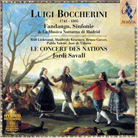 As my colleague Richard Freed reported in his
April SoundStage! review, these are elegant and gracious performances full of
lyricism, life, inspiration, and energy. The musicians of Le Concert des Nations are so
accomplished that they have no problems with difficult passages -- technique is in full
service to the music at hand, and from the very beginning, the listener is put at ease to
concentrate on the music. The sound is warm and spacious. In the multichannel mix, the
center channel is handled particularly well, in correct balance with the left and right.
This allows string and woodwind passages in the symphonies to be heard with singular
clarity. In the famous D-major quintet, the castanets, all too often recorded as if solo
instruments, are heard correctly balanced as accompaniment to the guitar and strings. The
surround channels do not call attention to themselves, yet add a realistic sense of
three-dimensional space. As my colleague Richard Freed reported in his
April SoundStage! review, these are elegant and gracious performances full of
lyricism, life, inspiration, and energy. The musicians of Le Concert des Nations are so
accomplished that they have no problems with difficult passages -- technique is in full
service to the music at hand, and from the very beginning, the listener is put at ease to
concentrate on the music. The sound is warm and spacious. In the multichannel mix, the
center channel is handled particularly well, in correct balance with the left and right.
This allows string and woodwind passages in the symphonies to be heard with singular
clarity. In the famous D-major quintet, the castanets, all too often recorded as if solo
instruments, are heard correctly balanced as accompaniment to the guitar and strings. The
surround channels do not call attention to themselves, yet add a realistic sense of
three-dimensional space.
Mozart: Violin Concertos 3-5
Andrew Manze, violin, conductor; The English Concert.
Harmonia Mundi HMU 807385, Hybrid Multichannel SACD.
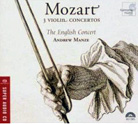 Many violinists have become conductors,
and many lead chamber orchestras -- after all, the concertmaster of an orchestra helps
keep the string section together. But not many violinists can keep an orchestra taut and
alert while paying attention to their own playing. Andrew Manze is a notable exception --
he can fiddle with the best, yet keeps his orchestra alert and on its toes. These buoyant
performances can go to the top of anyone’s list of favorite Mozart. Manze plays with
supreme virtuosity and artistry -- it’s wonderful to hear how he plays Mozart’s
ornamentations so that they complement the melody without detracting from it. He gets the
same sort of alert, joyous playing from his orchestra. One has the feeling that, together,
Manze and The English Concert have captured every ounce of lyricism, elegance, and humor
this music contains. The sound is robust, with ideal balances all the way around, a
relatively wide soundstage, and just the right amount of ambience in the rear channels.
The two-channel tracks have a bit less presence but are fine in their own right. Many violinists have become conductors,
and many lead chamber orchestras -- after all, the concertmaster of an orchestra helps
keep the string section together. But not many violinists can keep an orchestra taut and
alert while paying attention to their own playing. Andrew Manze is a notable exception --
he can fiddle with the best, yet keeps his orchestra alert and on its toes. These buoyant
performances can go to the top of anyone’s list of favorite Mozart. Manze plays with
supreme virtuosity and artistry -- it’s wonderful to hear how he plays Mozart’s
ornamentations so that they complement the melody without detracting from it. He gets the
same sort of alert, joyous playing from his orchestra. One has the feeling that, together,
Manze and The English Concert have captured every ounce of lyricism, elegance, and humor
this music contains. The sound is robust, with ideal balances all the way around, a
relatively wide soundstage, and just the right amount of ambience in the rear channels.
The two-channel tracks have a bit less presence but are fine in their own right.
Reubke: The Keyboard Works (Scherzo; Mazurka;
Piano Sonata in B-flat Minor; Trio in E-flat; Organ Sonata on Psalm 94)
John Owings, piano; H. Joseph Butler, organ.
Pro Organo SACD 7021. Hybrid Multichannel SACD.
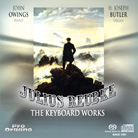 Julius Reubke (1834-1858) is one of the
enigmas of music history. His life was cut tragically short when he was but 24. Had he
lived longer, would he have composed more great music, or would he have slacked off and
burned out? The quality of the music we have indicates that the former possibility was the
more likely. What is not open to speculation is that this is a magnificent presentation of
the young composer’s keyboard works. Pianist John Owings and organist H. Joseph
Butler both play with a keen sense of the music’s dramatic and romantic nature, and
each is an assured virtuoso fully capable of handling the most difficult passages.
Producer and engineer Frederick Hohman is a double threat: An accomplished organist, he
also knows the world of audio engineering inside out, so it’s no surprise that he has
fashioned an outstanding-sounding disc. The piano has perfect presence and sparkles, and
the huge organ sounds impressive in soft solo passages and bombastic finales. Hohman
hasn’t recorded quite as much reverb in the rear channels as other engineers making
organ recordings, but it sounds just right for the location (Broadway Baptist Church in
Fort Worth, Texas). Julius Reubke (1834-1858) is one of the
enigmas of music history. His life was cut tragically short when he was but 24. Had he
lived longer, would he have composed more great music, or would he have slacked off and
burned out? The quality of the music we have indicates that the former possibility was the
more likely. What is not open to speculation is that this is a magnificent presentation of
the young composer’s keyboard works. Pianist John Owings and organist H. Joseph
Butler both play with a keen sense of the music’s dramatic and romantic nature, and
each is an assured virtuoso fully capable of handling the most difficult passages.
Producer and engineer Frederick Hohman is a double threat: An accomplished organist, he
also knows the world of audio engineering inside out, so it’s no surprise that he has
fashioned an outstanding-sounding disc. The piano has perfect presence and sparkles, and
the huge organ sounds impressive in soft solo passages and bombastic finales. Hohman
hasn’t recorded quite as much reverb in the rear channels as other engineers making
organ recordings, but it sounds just right for the location (Broadway Baptist Church in
Fort Worth, Texas).
Gerry Mulligan Meets Scott Hamilton: Soft
Lights & Sweet Music
Gerry Mulligan, Scott Hamilton, saxophones; Mike Renzi, piano; Jay Leonhart, bass; Grady
Tate, drums.
Mobile Fidelity USSACD 2017, Hybrid SACD.
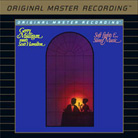 Mobile Fidelity Sound Lab has
made of this classic album a classic SACD. Gerry Mulligan was no stranger to recording
with other giants -- he had already "met" Stan Getz, Paul Desmond, Johnny
Hodges, Ben Webster, and Thelonious Monk. Those were great collaborations, but none was as
mellow or as totally satisfying as this one. Scott Hamilton had recorded two sets already
when he was asked to do this one, and his perspective from 2005 is printed in a new liner
note. The original notes by Peter Straub, from 1986, are also included. Mulligan and
Hamilton play hand in glove, trading ideas and styles and providing inspiration for each
other’s embellishments. The rhythm section was an inspired choice and provides
rock-steady support. The original Concord CD was excellent, but this SACD reveals extra
degrees of clarity and nuance, particularly in the sounds of the cymbals and the attacks
of Jay Leonhart’s bass notes. The players are spread out in a natural manner and the
distinction between Mulligan and Hamilton is clear, yet there’s no Ping-Pong effect,
as might be expected from an album featuring two horn soloists. Mobile Fidelity Sound Lab has
made of this classic album a classic SACD. Gerry Mulligan was no stranger to recording
with other giants -- he had already "met" Stan Getz, Paul Desmond, Johnny
Hodges, Ben Webster, and Thelonious Monk. Those were great collaborations, but none was as
mellow or as totally satisfying as this one. Scott Hamilton had recorded two sets already
when he was asked to do this one, and his perspective from 2005 is printed in a new liner
note. The original notes by Peter Straub, from 1986, are also included. Mulligan and
Hamilton play hand in glove, trading ideas and styles and providing inspiration for each
other’s embellishments. The rhythm section was an inspired choice and provides
rock-steady support. The original Concord CD was excellent, but this SACD reveals extra
degrees of clarity and nuance, particularly in the sounds of the cymbals and the attacks
of Jay Leonhart’s bass notes. The players are spread out in a natural manner and the
distinction between Mulligan and Hamilton is clear, yet there’s no Ping-Pong effect,
as might be expected from an album featuring two horn soloists.
...Rad Bennett
radb@ultraaudio.com

All contents copyright Schneider Publishing Inc., all rights
reserved.
Any reproduction, without permission, is prohibited.
Ultra Audio is part of the SoundStage! Network.
A world of websites and publications for audio, video, music, and movie enthusiasts. |

 Sony BMG has used imagination in
transferring the original three-channel master tapes of some RCA Living Stereo releases to
three-channel SACDs, but the latest reissues seem the weakest so far, even as such gems as
Fritz Reiner’s Spanish collection and Puccini’s Turandot still rest in
the vaults. Still, a few titles are outstanding. (All Living Stereo SACDs are hybrids,
with CD layers that can be played on regular CD or DVD players.)
Sony BMG has used imagination in
transferring the original three-channel master tapes of some RCA Living Stereo releases to
three-channel SACDs, but the latest reissues seem the weakest so far, even as such gems as
Fritz Reiner’s Spanish collection and Puccini’s Turandot still rest in
the vaults. Still, a few titles are outstanding. (All Living Stereo SACDs are hybrids,
with CD layers that can be played on regular CD or DVD players.) There are already two first-rate
recordings of Bartók’s famous Concerto for Orchestra available on SACD, one
conducted by Zoltán Kocsis [Hungaroton], the other the classic two-channel recording by
Fritz Reiner and the Chicago Symphony [RCA Living Stereo]. As incredible as it might seem,
Paavo Järvi’s reading surpasses both. From the opening notes, one is aware of a
feeling of keen anticipation, as each passage sets up the next. As the work unfolds, everything
sounds "right." Järvi is aware of the drama and lyricism implicit in the score,
as well as of both melodic line and accompaniment. After you’ve heard this recording
once, listen again, paying attention to the supporting instruments under the melody. I
have seldom heard a reading in which so much care has been taken with the instruments not
playing the tune. This recording is also proof positive that the Cincinnati Symphony has
become one of our great orchestras. Järvi has found a fascinating companion to the
Bartók in Lutoslawski’s dramatic work in the same form. The recorded sound is
perfect, with just the right amount of hall ambience. The orchestra sounds focused and
clear, with a warm halo of surrounding air. I never thought the Reiner recording would
lose first place, but from now on, for me, this is the reference recording of the
Bartók.
There are already two first-rate
recordings of Bartók’s famous Concerto for Orchestra available on SACD, one
conducted by Zoltán Kocsis [Hungaroton], the other the classic two-channel recording by
Fritz Reiner and the Chicago Symphony [RCA Living Stereo]. As incredible as it might seem,
Paavo Järvi’s reading surpasses both. From the opening notes, one is aware of a
feeling of keen anticipation, as each passage sets up the next. As the work unfolds, everything
sounds "right." Järvi is aware of the drama and lyricism implicit in the score,
as well as of both melodic line and accompaniment. After you’ve heard this recording
once, listen again, paying attention to the supporting instruments under the melody. I
have seldom heard a reading in which so much care has been taken with the instruments not
playing the tune. This recording is also proof positive that the Cincinnati Symphony has
become one of our great orchestras. Järvi has found a fascinating companion to the
Bartók in Lutoslawski’s dramatic work in the same form. The recorded sound is
perfect, with just the right amount of hall ambience. The orchestra sounds focused and
clear, with a warm halo of surrounding air. I never thought the Reiner recording would
lose first place, but from now on, for me, this is the reference recording of the
Bartók. Everyone presented on this disc,
composer and performers alike, is practically unknown in the US, yet they all won me over
to want to hear more. Ernst Toch (1887-1964) was for years mostly known by the 1958
Capitol Full Dimensional Sound recording of his Third Symphony, with William Steinberg and
the Pittsburgh Symphony. Recently, there has been a renaissance of his music. His other
symphonies have now been recorded, along with many other compositions. This disc presents
the robust and quite listenable Piano Concerto, which bubbles along like something
of a cross between Bartók and Shostakovich; and the more astringent Piano Quintet.
Diane Andersen, who specializes in recording little-known music, is a powerhouse soloist
who can shade her playing from the softest whisper to a thunderous shout, and both the
orchestra and the Danel Quartet give first-rate support. The sound is amazingly clear,
with remarkable presence. Listen to the low gong strokes at the end of the concerto’s
third movement, or the hammering percussion and piano at the beginning of the final
movement, and prepare to be amazed. I would love to hear these forces make an integral
recording of the Bartók piano concertos.
Everyone presented on this disc,
composer and performers alike, is practically unknown in the US, yet they all won me over
to want to hear more. Ernst Toch (1887-1964) was for years mostly known by the 1958
Capitol Full Dimensional Sound recording of his Third Symphony, with William Steinberg and
the Pittsburgh Symphony. Recently, there has been a renaissance of his music. His other
symphonies have now been recorded, along with many other compositions. This disc presents
the robust and quite listenable Piano Concerto, which bubbles along like something
of a cross between Bartók and Shostakovich; and the more astringent Piano Quintet.
Diane Andersen, who specializes in recording little-known music, is a powerhouse soloist
who can shade her playing from the softest whisper to a thunderous shout, and both the
orchestra and the Danel Quartet give first-rate support. The sound is amazingly clear,
with remarkable presence. Listen to the low gong strokes at the end of the concerto’s
third movement, or the hammering percussion and piano at the beginning of the final
movement, and prepare to be amazed. I would love to hear these forces make an integral
recording of the Bartók piano concertos. As my colleague Richard Freed
As my colleague Richard Freed  Many violinists have become conductors,
and many lead chamber orchestras -- after all, the concertmaster of an orchestra helps
keep the string section together. But not many violinists can keep an orchestra taut and
alert while paying attention to their own playing. Andrew Manze is a notable exception --
he can fiddle with the best, yet keeps his orchestra alert and on its toes. These buoyant
performances can go to the top of anyone’s list of favorite Mozart. Manze plays with
supreme virtuosity and artistry -- it’s wonderful to hear how he plays Mozart’s
ornamentations so that they complement the melody without detracting from it. He gets the
same sort of alert, joyous playing from his orchestra. One has the feeling that, together,
Manze and The English Concert have captured every ounce of lyricism, elegance, and humor
this music contains. The sound is robust, with ideal balances all the way around, a
relatively wide soundstage, and just the right amount of ambience in the rear channels.
The two-channel tracks have a bit less presence but are fine in their own right.
Many violinists have become conductors,
and many lead chamber orchestras -- after all, the concertmaster of an orchestra helps
keep the string section together. But not many violinists can keep an orchestra taut and
alert while paying attention to their own playing. Andrew Manze is a notable exception --
he can fiddle with the best, yet keeps his orchestra alert and on its toes. These buoyant
performances can go to the top of anyone’s list of favorite Mozart. Manze plays with
supreme virtuosity and artistry -- it’s wonderful to hear how he plays Mozart’s
ornamentations so that they complement the melody without detracting from it. He gets the
same sort of alert, joyous playing from his orchestra. One has the feeling that, together,
Manze and The English Concert have captured every ounce of lyricism, elegance, and humor
this music contains. The sound is robust, with ideal balances all the way around, a
relatively wide soundstage, and just the right amount of ambience in the rear channels.
The two-channel tracks have a bit less presence but are fine in their own right. Julius Reubke (1834-1858) is one of the
enigmas of music history. His life was cut tragically short when he was but 24. Had he
lived longer, would he have composed more great music, or would he have slacked off and
burned out? The quality of the music we have indicates that the former possibility was the
more likely. What is not open to speculation is that this is a magnificent presentation of
the young composer’s keyboard works. Pianist John Owings and organist H. Joseph
Butler both play with a keen sense of the music’s dramatic and romantic nature, and
each is an assured virtuoso fully capable of handling the most difficult passages.
Producer and engineer Frederick Hohman is a double threat: An accomplished organist, he
also knows the world of audio engineering inside out, so it’s no surprise that he has
fashioned an outstanding-sounding disc. The piano has perfect presence and sparkles, and
the huge organ sounds impressive in soft solo passages and bombastic finales. Hohman
hasn’t recorded quite as much reverb in the rear channels as other engineers making
organ recordings, but it sounds just right for the location (Broadway Baptist Church in
Fort Worth, Texas).
Julius Reubke (1834-1858) is one of the
enigmas of music history. His life was cut tragically short when he was but 24. Had he
lived longer, would he have composed more great music, or would he have slacked off and
burned out? The quality of the music we have indicates that the former possibility was the
more likely. What is not open to speculation is that this is a magnificent presentation of
the young composer’s keyboard works. Pianist John Owings and organist H. Joseph
Butler both play with a keen sense of the music’s dramatic and romantic nature, and
each is an assured virtuoso fully capable of handling the most difficult passages.
Producer and engineer Frederick Hohman is a double threat: An accomplished organist, he
also knows the world of audio engineering inside out, so it’s no surprise that he has
fashioned an outstanding-sounding disc. The piano has perfect presence and sparkles, and
the huge organ sounds impressive in soft solo passages and bombastic finales. Hohman
hasn’t recorded quite as much reverb in the rear channels as other engineers making
organ recordings, but it sounds just right for the location (Broadway Baptist Church in
Fort Worth, Texas). Mobile Fidelity Sound Lab has
made of this classic album a classic SACD. Gerry Mulligan was no stranger to recording
with other giants -- he had already "met" Stan Getz, Paul Desmond, Johnny
Hodges, Ben Webster, and Thelonious Monk. Those were great collaborations, but none was as
mellow or as totally satisfying as this one. Scott Hamilton had recorded two sets already
when he was asked to do this one, and his perspective from 2005 is printed in a new liner
note. The original notes by Peter Straub, from 1986, are also included. Mulligan and
Hamilton play hand in glove, trading ideas and styles and providing inspiration for each
other’s embellishments. The rhythm section was an inspired choice and provides
rock-steady support. The original Concord CD was excellent, but this SACD reveals extra
degrees of clarity and nuance, particularly in the sounds of the cymbals and the attacks
of Jay Leonhart’s bass notes. The players are spread out in a natural manner and the
distinction between Mulligan and Hamilton is clear, yet there’s no Ping-Pong effect,
as might be expected from an album featuring two horn soloists.
Mobile Fidelity Sound Lab has
made of this classic album a classic SACD. Gerry Mulligan was no stranger to recording
with other giants -- he had already "met" Stan Getz, Paul Desmond, Johnny
Hodges, Ben Webster, and Thelonious Monk. Those were great collaborations, but none was as
mellow or as totally satisfying as this one. Scott Hamilton had recorded two sets already
when he was asked to do this one, and his perspective from 2005 is printed in a new liner
note. The original notes by Peter Straub, from 1986, are also included. Mulligan and
Hamilton play hand in glove, trading ideas and styles and providing inspiration for each
other’s embellishments. The rhythm section was an inspired choice and provides
rock-steady support. The original Concord CD was excellent, but this SACD reveals extra
degrees of clarity and nuance, particularly in the sounds of the cymbals and the attacks
of Jay Leonhart’s bass notes. The players are spread out in a natural manner and the
distinction between Mulligan and Hamilton is clear, yet there’s no Ping-Pong effect,
as might be expected from an album featuring two horn soloists.